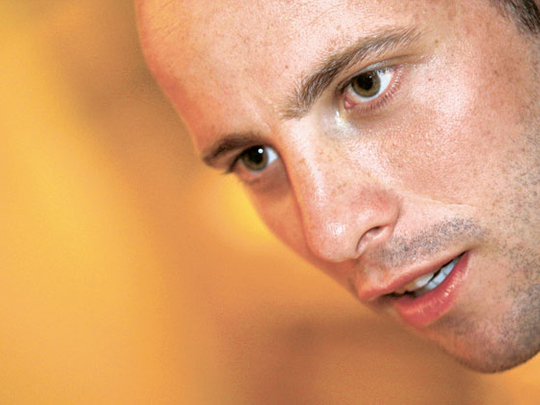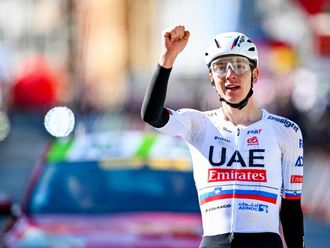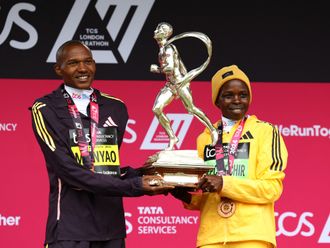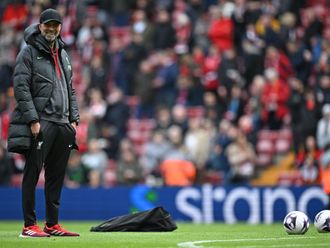
Los Angeles: To best understand the athletic pursuits of Oscar Pistorius, it would be ideal to walk a mile in his shoes. Except, we can't. When Pistorius competes, he runs on artificial limbs known as Cheetah Flex-Foot prosthetics.
They are shaped like the letter ‘J', are made by a company (Ossur) with headquarters in Iceland and connect to the leg just below the knee. Their appearance, and Pistorius' speed, have brought him the nickname ‘The Blade Runner'.
If you were an editor or network TV producer compiling a list of the likely best stories to come out of the 2012 Olympics in London, Pistorius' would be near the top. He is trying to make the Games, as a member of the South African Olympic team, in the 400 metres. Not the Paralympics.
Defending champion
He is already the defending champion from Beijing in the Paralympic 100, 200 and 400 metres. We are talking about the Big Show — the brightest lights and biggest crowds. If Pistorius gets there, he may represent the pinnacle of overcoming.
Pistorius was born to Henke and Sheila Pistorius in Johannesburg on November 22, 1986. He had no fibula in either leg and had both amputated below the knee when he was 11 months old. In most homes, that would bring years of gloom and hand-wringing. Not so in the Pistorius household.
"I grew up in a home where disability was not an issue," Pistorius says. My parents made me realise what I had, not what I didn't have."
Pistorius' disability slowed him down so much that, as a child, he competed only in water polo, tennis, wrestling and rugby. Perhaps the family tone was best established when Pistorius was "four or five years old." His brother Carl, two years his senior, had a go-kart that he allowed nobody near, especially his younger brother. But one day, Carl decided he wanted to have a real speed test, and so he invited Oscar along.
Mickey Mouse leg
"We got going faster and faster," Oscar recalls, "and pretty soon, we were past the point where we could pull up. But he kept going. The wheels were vibrating and we were going to crash. But just as we got near a barrier, he grabbed my Mickey Mouse leg, jammed it down and stopped us."
The legs once used for a brake are now world-class accelerators. Pistorius started running in 2004, "never looked back" and now could make the 400-metre prelims one of the biggest stories of the London Games. Ossur has made the "blade runners" since 1997, but no athlete had been able to approach an Olympic level using them. Until Pistorius.
And now that he has overcome the political storm in international track and field that his performances created, he has a single focus — running an Olympic qualifying time. He couldn't even think that until May 2008, just two months before the Beijing Olympics. For a while, he had been banned by the IAAF, the international track federation. It had concluded that his blades gave him an advantage over runners with regular legs.
He appealed, took his case to the Court of Arbitration for Sport (CAS) and spent a great deal of time working with a team of independent scientists from MIT and Rice, as they gathered evidence. When CAS analysed the evidence and overruled the IAAF, Pistorius was free to pursue his Olympic dream.
Advantage
"It's not an opinion that I don't have an advantage," he says. "It's fact. It's science. It is not my job to change people's minds. It is my job to make the qualifying time." The qualifying time for the London Games is 45.25 seconds.
In South Africa, a time of 45.25 gets Pistorius on the team, and a "B" qualifying time of 45.70 — he has done that several times — might also be good enough, depending on other athletes in the country. Pistorius' best time ever is 45.61.
Last Saturday, at the Adidas Grand Prix in New York, he ran 45.69, despite wind and rain that affects him more than the able-bodied runners because of traction problems.
He has a half-dozen or so races still to come this summer to achieve the "A" qualifying time of 45.25. If he makes it to the world championships in August in South Korea, with the same qualifying standards, he will be the first with his disability to compete on that level. Same with the Olympics.
He has no illusions of grandeur about getting to the medal podium. "I just want to get there," Pistorius says, "and I'm not allowing myself to even think that I won't make it."
Pistorius devotes his spare time, of which he has little, to his stable of five thoroughbred horses in South Africa.
He describes each with pride of ownership, speaks enthusiastically about their fine breeding, and excitedly shows a reporter the film of a recent impressive victory by his prized horse Watchful. There is little question that Oscar Pistorius is a student of fine legs.











